Exploring the Allure of White Jewelry Stones

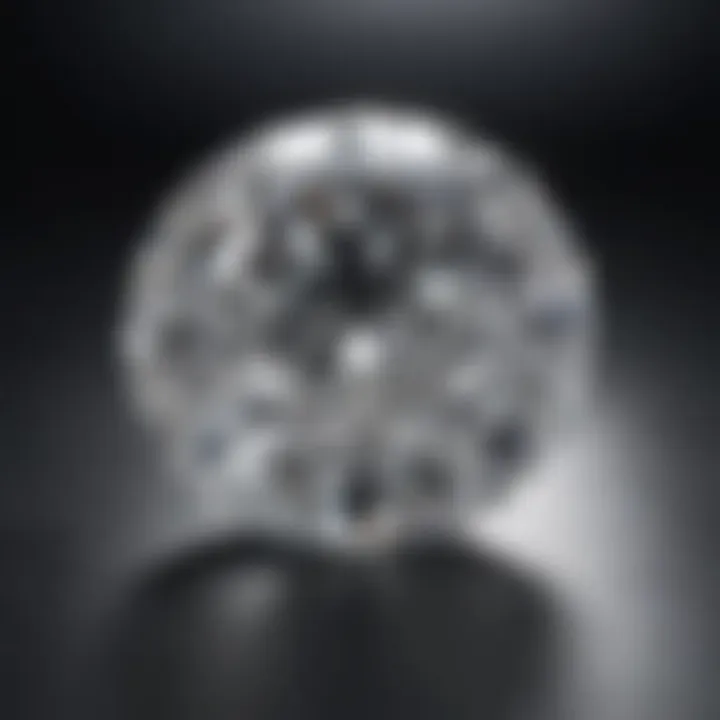
Intro
White jewelry stones possess a timeless charm that captivates both casual admirers and dedicated enthusiasts. Their ethereal beauty often transcends mere aesthetics, leading to deeper inquiries about their significance and varied characteristics. Within the realm of gemstones, white stones stand apart, often symbolizing purity and elegance, which makes them a staple in both traditional and contemporary jewelry designs.
As you delve into the allure of these stunning stones, it’s vital to grasp not only what they are but also how they've carved their niche across cultures and histories. Here’s an insightful overview of these captivating gems, alongside a look into their rich past and the stories they tell.
Preface to White Jewelry Stones
White jewelry stones hold a distinctive charm among gemstone enthusiasts and collectors. These stones are often associated with purity, elegance, and sophistication. Understanding their allure is not just about admiring their aesthetic appeal; it’s also about grasping the intricacies that lie beneath their surface.
Defining White Gemstones
To truly appreciate white gemstones, one must first recognize what differentiates them from other stones. White gemstones are characterized by their luminous appearance and colorless or very light hue. This lack of color allows them to be versatile — they complement various styles and can be paired effortlessly with other colored stones.
Common examples include diamonds, white sapphires, and the ethereal moonstone. These stones can exhibit varying degrees of clarity, brilliance, and unique optical properties such as asterism in some cases. Their definitions extend beyond merely physical traits; they also encapsulate cultural significance and personal associations which often go hand in hand.
Historical Context
The history of white jewelry stones is as varied as the stones themselves. Throughout time, cultures have revered these gems for their beauty and purported metaphysical properties. In ancient civilizations, white stones were often seen as symbols of the divine. For instance, the Greeks believed that diamonds were actually the tears of the gods.
In a different vein, many cultures have woven white gemstones into their spiritual and medicinal practices. For example, the moonstone, revered by various cultures, has been deemed a source of energy and calmness. Its white sheen is not just beautiful, but it has also attracted legends and stories that enrich its value, both as a piece of jewelry and as a talisman.
In summary, the charm of white jewelry stones is a blend of their physical attributes and historical narratives. From the purity associated with white gems to their spiritual implications across various cultures, they encapsulate a world of meanings worth exploring. As the article unfolds, we will delve deeper into their classifications, properties, and the significance they carry in both modern and historical contexts.
Classification and Types
Understanding the classification and types of white jewelry stones is crucial to grasping their unique qualities and appeal. Each type of stone carries distinct characteristics that influence its appeal in both ornamental and investment contexts. By recognizing the differences, enthusiasts can navigate the choices available more effortlessly, making informed decisions that suit their personal tastes and needs.
The importance goes beyond mere aesthetics; the type of white stone can determine the market price and future value. Certain stones attract more interest and demand than others, making classification essential for anyone looking to collect or design jewelry.
Common White Gemstones
Diamond
Diamonds have captured the hearts of many, not just for their shimmer, but also for their legendary status in the world of gemstones. The inherent brilliance of diamonds comes from their high refractive index, which gives them an unmatched sparkle. This key characteristic makes diamonds a timeless favorite in jewelry — marriages often hinge on the presence of that radiant stone.
Aside from their stunning look, diamonds are also incredibly durable. They rank a solid 10 on the Mohs scale of hardness, making them hard to scratch or chip. However, this strength can bear some downsides; for instance, thus can make a chipped diamond more noticeable. People might mistakenly think it diminished value.
White Sapphire
White sapphires present an alluring alternative to diamonds. Despite lacking the same level of brilliance, their clarity can be strikingly impressive. One of the qualities making white sapphires appealing is their relatively lower cost compared to diamonds, allowing those on a budget to enjoy elegant styles without breaking the bank.
Another unique feature of white sapphires is their actual durability, ranking around 9 on the Mohs scale. This makes them suitable for everyday wear; however, their surface can show scratches more easily than diamonds, so it is good to handle them with a bit of care.
Moonstone
Moonstone offers a fascinating optical phenomenon known as adularescence, where a soft glow seems to float just beneath the surface. This ethereal quality gives moonstone a magical aesthetic often associated with lunars and mysticism. Many are drawn to moonstone due to its captivating appearance and relatively affordable price.
While moonstones are typically not as hard as diamonds or sapphires, sitting around 6 to 7 on the Mohs scale, they do contribute richness to a collection. Care needs to be exercised during wear and cleaning, as they might chip or fracture if encountered with harsher impact.
White Opal
Unlike other gemstones, white opals boast a kaleidoscope of colors created by an array of tiny silica spheres within the stone. This unique play of color can mesmerize viewers, making it a desired choice for various pieces. Opals are embedded with a vivacious spirit that draws many gemstone lovers.
However, white opals are more fragile than their counterparts, sitting around 5.5 to 6.5 on the Mohs scale. This means wearers should treat them delicately and prevent abrupt impacts to retain their vibrant beauty in a ring or pendant.
Rare Varieties

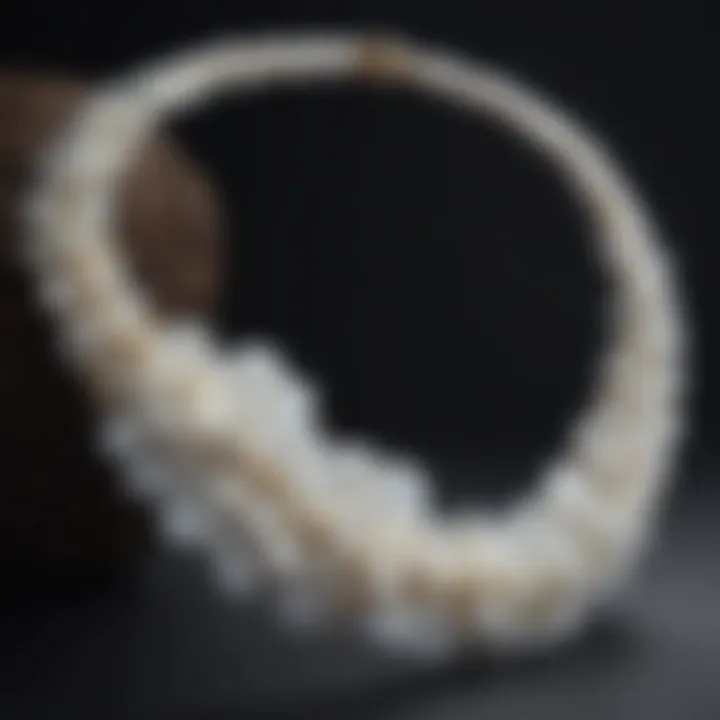
White Coral
White coral is not just admired for its look but also for its rich historical significance. Often used in jewelry-making, it adds a certain distinctiveness. Its naturally organic origin gives it an allure that synthetic materials can hardly replicate.
However, the sustainability issue surrounding coral can be a drawback. The collective effort to preserve marine life must be on the minds of those acquiring this type of stone. Even beautiful, the environmental impact of harvest should always be a consideration.
White Jadeite
Known for its toughness and deep cultural ties, particularly in Asian societies, white jadeite conveys tranquility and purity. Its beauty transcends simple chic; it’s often infused with emotional significance, such as being a symbol of protection and good health.
The downside might be the pricing; authentic jadeite can fetch high market value, sometimes leaving collectors in a conundrum about genuine pieces versus imitations. Even visually knowing the features of genuine jadeite can be quite beneficial.
White Zircon
Often confused with cubic zirconia, real white zircon shines in its own right with exceptional brilliance and fire. Not only is it an eco-friendly alternative, but its historical importance as one of the oldest gemstones gives it an extra charm. It displays captivating clarity but lacks the hardness of its diamond siblings, landing around 6 to 7.5 on the Mohs scale.
Despite this, discreet wear is recommended to avoid scattering the beautiful stone; a bit of care can extend its lifetime considerably.
In sum, each category of white gemstones brings distinctive aspects, appealing to various bases of enthusiasts and designers. By understanding these classifications—common and rare—one can truly appreciate their value and select pieces that enrich their individual collections.
Physical Properties of White Stones
Understanding the physical properties of white stones is indispensable for anyone who appreciates the beauty and value of these gemstones. These properties not only influence the aesthetic appeal of the stones but also determine their suitability for different types of jewelry and their longevity. When we're talking about white jewelry stones, aspects like color and clarity, hardness and durability play an undeniably pivotal role in both their allure and practicality.
Color and Clarity
Color is often the first attribute that captures attention. In the realm of gemstones, color can be quite complex. While one might think white is simply white, it can manifest in various shades—from icy, almost translucent whites to those imbued with a touch of warmth like creamy or milky hues. For example, consider the difference between a pure white diamond and a white opal. The diamond’s clarity allows light to dance within it, offering exceptional brilliance, while opal has a more ethereal, softer appearance, often showing hints of other colors due to its unique structure.
Clarity is another essential aspect. Flaws, often called inclusions, can detract from the overall beauty of a stone. A clear white gemstone glistens without distractions, making it more desirable. In contrast, a stone with visible inclusions, albeit natural, may not pique the interest of a collector or designer as quickly. This level of clarity can sometimes influence market value, leading buyers to invest more in stones that are visually pure.
Indeed, the allure of white stones lies not merely in their hue but in how light interacts with their clarity.
Hardness and Durability
Next up, we have hardness and durability, which are perhaps the most critical factors when considering a piece for everyday wear. The hardness of a gemstone is measured on the Mohs scale, which ranks minerals from 1 (talc) to 10 (diamond). Diamonds, being the hardest, score a solid 10, whereas softer stones like pearl only reach a 2. If you’re a collector or designer, knowing where a stone lies on this scale can help you decide its suitability for rings, necklaces, or bracelets that undergo daily wear.
Durability encompasses not just hardness but also resistance to scratching, breaking, or even fading over time. For instance, while a diamond might be tough to scratch, its brittle nature can lead to chipping if improperly handled. So, a white sapphire, slightly lower on the hardness scale, may seem less luxurious but can offer greater peace of mind when worn in more active settings.
In summary, the physical properties of white stones shape their visual appeal and application in jewelry design. Understanding their color, clarity, hardness, and durability can mean the difference between a gem that dazzles for generations and one that loses its luster over time.
Metaphysical Properties
The exploration of white jewelry stones transcends mere aesthetics; it delves into the world of metaphysical properties that are often intricately woven into their very essence. Many gemstone enthusiasts believe that these properties can influence the beholder’s energy, emotions, and even health. Whether you regard metaphysics as a source of personal empowerment or as a benevolent tool for self-discovery, understanding these aspects adds a rich layer to the appreciation of white gemstones.
Symbolism and Meaning
White jewelry stones carry a vast array of symbolic meanings, varying from purity to enlightenment. Many cultures link white to the idea of new beginnings and clarity of thought.
For example, the diamond, often seen as the ultimate representation of love and fidelity, also symbolizes strength and eternal commitment. Similarly, the moonstone, with its shimmering glow, is thought to possess a connection to the lunar forces, fostering intuition and emotional balance.
Some common interpretations include:
- Purity and Innocence: The bright and clear appearance of white stones is frequently associated with purity, making them ideal for special occasions like weddings.
- Clarity and Vision: White gemstones are said to enhance mental clarity and enlightenment, serving as a beacon for those seeking direction in their lives.
- Protection and Healing: Many believe that these stones offer protection against negativity, allowing one's inner light to shine brighter.
“In the realm of white gemstones, the essence of symbolism often inspires profound connections within oneself and one’s environment.”
Uses in Healing and Meditation
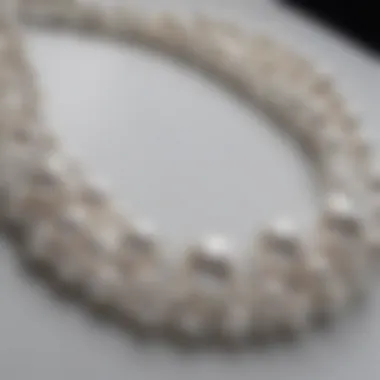
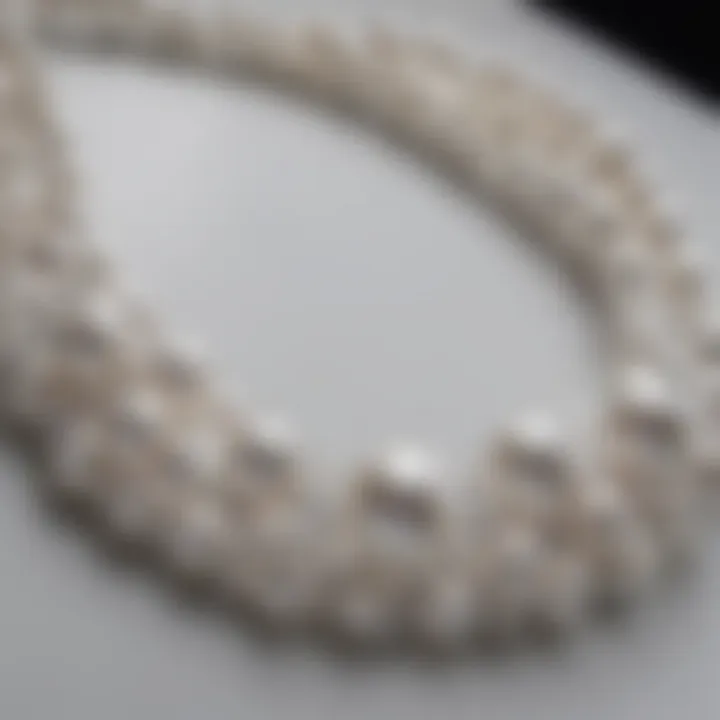
When discussing white jewelry stones, their role in healing practices cannot be disregarded. From meditation to energy work, many practitioners incorporate these stones in rituals or personal practices. Each stone presents specific attributes that can enhance certain aspects of healing.
- Diamond: Symbols of clarity and strength, diamonds are often used in meditation to foster emotional resilience and bring forth inner wisdom.
- Moonstone: This stone is connected to the moon's energy, thus enhancing emotional healing and fostering calmness. Meditators often utilize moonstone to promote dreams and spiritual growth.
- White Opal: Known for its ability to help manifest one’s dreams, this stone is often placed on the heart during meditation to reconnect with one’s higher self and promote emotional healing.
White gemstones can be integrated into daily rituals as well. For example, wearing these stones or keeping them in a personal space can change the energy around the individual. It's essential to remember, though, that one’s mindset plays a crucial role in how the energy manifests.
In summary, the metaphysical properties of white gemstones provide not just aesthetic appeal but a profound connection to deeper meanings and healing practices. By exploring their symbolism and uses in spiritual rituals, individuals can unlock various avenues for emotional and spiritual enrichment.
Market Trends and Valuation
Understanding the market trends and valuation of white jewelry stones is crucial for both collectors and enthusiasts alike. This section sheds light on the current landscape of these striking gemstones and evaluates their investment potential. As with any collectible, recognizing the nuances of market demand, availability, and valuation impacts how individuals may appreciate or utilize these stones in jewelry. Navigating this sphere can help collectors make informed decisions, ensuring they get the best value while also fostering a deeper connection with the jewelry they cherish.
Current Market Overview
In recent years, white gemstones have gained a notable foothold in the global jewelry market. Their unique aesthetic appeal, coupled with their versatility, has propelled them into the spotlight. Diamonds still hold the crown, but other contenders like white sapphires and moonstones are on the rise. This trend can be attributed to several factors:
- Increased awareness about various gemstones has led to a broader appreciation.
- Social media platforms allow designs featuring these stones to reach a wider audience, influencing purchasing decisions.
- Branding through celebrities donning white jewelry stones has captivated public interest.
The demand for ethically sourced gemstones is also shaping the market. Consumers are becoming more conscious of the origins of the stones they purchase. This emphasizes a trend towards sustainability, leading to a growing preference for conflict-free diamonds and lab-grown alternatives. According to various market analyses, retail sales of white jewelry stones have shown a steady increase. However, fluctuations can occur based on economic conditions, so staying informed is paramount.
"The allure of white gemstones is amplified by their connection to purity and elegance, making them perpetual favorites in the jewelry world."
Investment Potential
Investing in white jewelry stones can offer substantial returns, given that these stones often appreciate over time. Unlike typical investments, gemstones also carry an intangible allure; their beauty makes them not only assets but also personal treasures. Here are some considerations for potential investors:
- Rarity: Some white gemstones, like white jadeite or white zircon, are far rarer than their more well-known counterparts. Rarity often correlates with value.
- Condition: The overall condition of the gemstone plays an essential role in its valuation. Flawless gems tend to attract higher prices in the market.
- Market Cycles: Often, gemstone values can rise and fall based on trends. Keeping an eye on fashion and cultural shifts that influence these trends can be beneficial.
- Documentation: Authenticating your gemstone with certifications from reputable sources can significantly increase its resale value. A well-documented stone often stands as a more attractive investment.
In summary, while the allure of white gemstones captivates collectors, understanding market dynamics and making informed choices can truly enhance one's engagement and investment in these beautiful stones.
Caring for White Jewelry Stones
When it comes to white jewelry stones, the care you extend to these delicate treasures can significantly make or break their aesthetic appeal and longevity. After all, gemstones like diamonds, white sapphires, and moonstones represent more than just a pretty face; they encapsulate a blend of artistry, history, and sometimes sentimental value. Proper care not only maintains their shimmering beauty but also protects your investment for years to come.
Cleaning Techniques
Cleaning white gemstones should be approached with a touch of finesse. Using harsh chemicals or abrasive tools can lead to scratches, dullness, or even cracks. Instead, opt for gentler methods that keep your stones sparkling while preserving their integrity.
- Warm Soapy Water: Mix a few drops of mild dish soap in lukewarm water. Soak your jewelry for a few minutes to let grime loosen.
- Soft Brush: Employ a soft-bristled brush, like an old toothbrush, to gently scrub away any remaining dirt. This is particularly useful for intricate designs where dirt can easily hide.
- Rinsing: After cleaning, rinse the jewelry under running water while ensuring the stone is not lost down the drain.
- Drying: Use a lint-free cloth to pat the piece dry. Avoid using paper towels as they may leave fibers behind.
Tip: Regular maintenance - cleaning should ideally be done once a month. A little active care goes a long way in keeping those white stones dazzling.
Storage Recommendations
Storing white jewelry stones correctly is just as crucial as cleaning them. Improper storage can lead to scratches, tarnishing, or even loss. Here are some useful suggestions for keeping your treasures safe:
- Separate Storage: Always store each piece separately to prevent them from scratching each other. A soft pouch or a compartmentalized jewelry box works wonders.
- Avoid Sunlight: Direct sunlight can fade the luster of some stones over time. Keep your collection in a cool, dark place.
- Humidity Control: Excess moisture can impact certain stones. Consider using silica gel packets in storage boxes to help manage humidity levels.
- Regular Check-ups: It doesn’t hurt to periodically inspect your pieces for any signs of wear or damage. Fixing minor issues early can save major headaches later.
By following these cleaning techniques and storage recommendations, you not only protect the physical aspects of your white jewelry stones, but you also honor the stories and beauty they carry within them.
Caring for these stones is an act of appreciation, ensuring they continue to add charm and elegance to your life.
White Stones in Fashion
The world of fashion, particularly jewelry, thrives on trends that resonate deeply with both personal style and cultural narratives. White stones play a significant role in this sphere, cherished for their versatility and timeless elegance. These jewels offer unique benefits, allowing designers to express creativity while also appealing to a diverse audience. Moreover, the adaptability of these stones ensures they find a place in various fashion scenarios, from casual chic to formal grandeur.
White stones have a distinct charm that can elevete any outfit, making them an essential consideration for both designers and consumers. They often symbolize purity, clarity, and new beginnings, attributes that resonate with many individuals looking to make a statement. When worn, they can serve to enhance one's natural beauty by providing a striking contrast against varying skin tones. This adaptability makes white jewelry stones a staple in collections that seek to appeal to a wide audience.
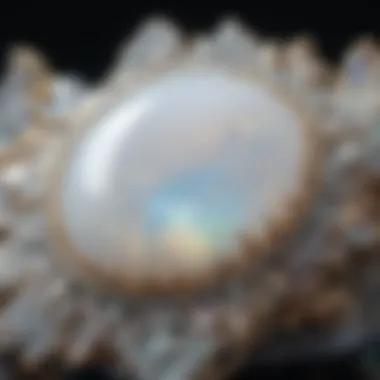
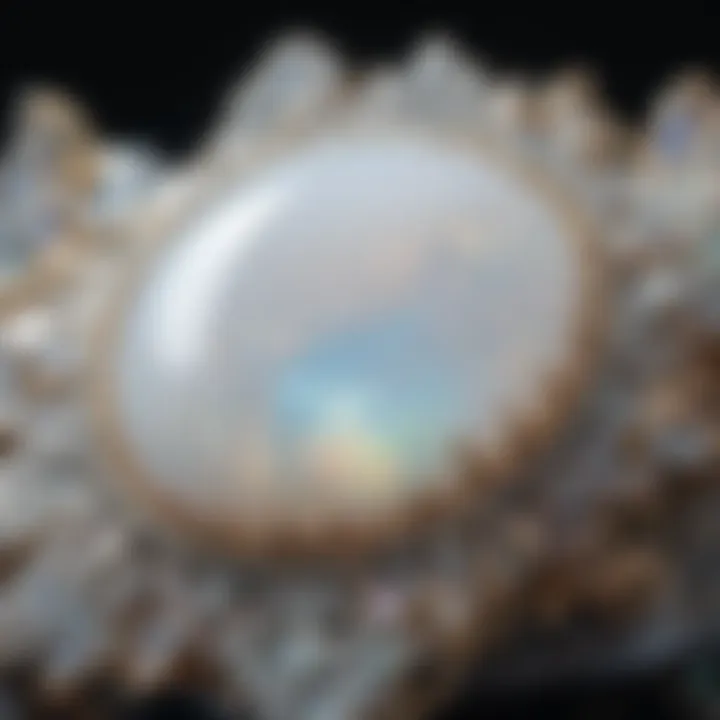
Jewelry Design Trends
In the realm of jewelry design, simplicity often speaks volumes. Current trends show a strong inclination towards minimalist designs that highlight the natural beauty of white stones. These designs offer a clean, uncluttered look that can seamlessly integrate into various fashion ensembles. For instance, a delicate white sapphire pendant can add a touch of elegance to a monochromatic outfit or even bring out the subtleties in textured fabrics.
Moreover, there is a growing trend toward incorporating mixed materials. Designers are teaming up white stones with contrasting elements like gold or wood, creating pieces that are both eye-catching and sophisticated. The juxtaposition of materials speaks to a modern aesthetic, appealing particularly to younger consumers who desire uniqueness in their jewelry choices.
"In jewelry, less is often more, and white stones deliver that in spades."
Some notable trends include:
- Layered Necklaces: Delicate chains featuring various white stones for a modern look.
- Statement Pieces: Larger, bold designs that serve as conversation starters.
- Nature-Inspired Designs: Jewelry that mimics the forms found in nature, incorporating white stones into petals or leaves imprinted in metal.
Celebrity Influence
Celebrities often serve as trailblazers for trends in accessories, and white stones have become a favorite amongst them. Imagine seeing a red-carpet event where a renowned actress dazzles in a diamond-studded bracelet or white opal earrings—these moments set the tone for public perception and desirability of such stones.
Recent years have seen numerous high-profile figures sporting pieces that incorporate white stones. Their choices not only elevate the pieces but also build a narrative around the stones. For example, when a celebrity opts for a classic pearl necklace, it can reignite interest in similar styles among the general populace, leading to an uptick in sales for jewelers who carry white stones in their collections.
This phenomenon illustrates how celebrity endorsements translate directly into market vitality. Fans oftentimes wish to emulate their favorite stars, thus creating a ripple effect in the fashion industry. Also, social media has played a crucial role in this, showcasing jewelry prominently and making white stones more relatable and desired.
In summary, the adaptation of white stones in fashion is not merely a fleeting whim but a strong trend fueled by the desire for elegance, personal expression, and cultural significance. The continued exploration of their uses and variations within design ensures that they remain relevant and desirable for years to come.
Cultural Significance
The cultural significance of white jewelry stones extends beyond mere aesthetics. They have been intertwined with human history for centuries, echoing tales that span different civilizations and epochs. These gemstones are not just beautiful objects; they often symbolize purity, clarity, and new beginnings. Many cultures regard white stones as bearers of light, reflecting the innate desire for transcendence and spiritual elevation.
Myths and Legends
Across the globe, white gemstones hold deep-rooted legends, often attributed with mystical qualities. For instance, in ancient Greece, diamonds were believed to be tears of the gods, a notion that denoted their divine connection. Similarly, many native tribes view white stones as protective talismans, believed to guard against negative spirits.
The stone of the moon — moonstone — is closely linked to lunar deities in various cultures and is thought to enhance intuition. A tale from the East Asia speaks of moonstone being a bridge between two lovers separated by destiny, lighting their path in the dark. Legends like these enhance their allure, weaving a narrative that pulls at the heartstrings.
Moreover, in the realm of healing, white stones have found their way into folklore as effective agents for psychological and emotional healing. For example, the use of white opal in ancient rituals is often recounted as a stone to calm racing thoughts and instill hope. The layers of meaning behind these gemstones underscore their importance in cultural lore.
Traditions Around the World
As one peeks into the traditions surrounding white gemstones, it becomes clear how societies weave them into the fabric of celebrations, rituals, and personal milestones. In India, white diamonds are traditionally gifted on significant occasions like weddings as symbols of everlasting love. The tradition suggests that such stones capture the essence of marital vows, solidifying bonds through time.
Meanwhile, in Western cultures, the symbolism of white stones often manifests during christenings, marking purity and new life. These gemstones find their footing in the hands of enthusiasts, collectors, and even casual gift-givers. Jewelry pieces adorned with white stones are cherished for their understated beauty, often featuring in sentimental gifts.
In Japan, the use of white coral in traditional arts highlights not only aesthetic appeal but also the belief in fostering longevity and protection from misfortune. Such cultural richness adds layers to their value, offering enthusiasts a unique insight into the diverse perceptions shaped by local customs.
"White stones are more than mere adornments; they embody stories, beliefs, and traditions that transcend generations."
This mosaic of myths and traditions offers a glimpse of the deeper meanings embedded in white jewelry stones. Their roles do not only lie in ornamentation but also in connecting people with their roots, beliefs, and shared histories. The cultural significance of these gemstones will continue to inspire admiration and usage in practices that honor their captivating essence.
Closure
The significance of the conclusion in this article cannot be overlooked. It serves as the final aggregation of all insights gathered, offering a reflective perspective on white jewelry stones. While the journey through the characteristics, meanings, and cultural impacts of these stunning gems is intellectually enriching, the conclusion encapsulates the essence of that exploration. It allows readers to grasp the core messages and synthesize the information presented throughout the sections.
Summary of Insights
White jewelry stones have been a source of fascination across various cultures and historical epochs. Their beauty and durability make them popular in both fashion and ceremonial uses. Key points to remember include the diversity of white gemstones like diamonds, white sapphires, and moonstones, each with unique properties. Metaphysical aspects also contribute to their allure, as many believe these stones hold symbolic significance that goes beyond aesthetics.
Additionally, the article addressed the practical aspects of owning and caring for these gemstones, ensuring their longevity and brilliance. Market trends have shown that interest in white stones continues to grow, making them not just aesthetic treasures but also wise investment choices.
It is important for enthusiasts and gem collectors to stay informed about their value and care techniques, which ultimately contribute to the appreciation of these exquisite stones.
Future of White Gemstones
Looking ahead, the future of white gemstones appears bright. As market dynamics change and consumer preferences evolve, these stones will likely hold a revered place in the world of jewelry. Sustainability trends are becoming a focal point, prompting gem producers to ensure ethical sourcing. This shift will not only enhance the appeal of white stones but also their value in the long term.
The fusion of technology and luxury jewelry design offers exciting possibilities. Enhanced methods for gemstone grading and lab-grown alternatives provide options that cater to a discerning audience.
In summary, as technology and public awareness about ethical practices evolve, white gemstones will undoubtedly continue to charm enthusiasts, collectors, and connoisseurs alike. The potential for innovation in design, care, and market approach suggests that these stones will not merely remain in the background; they are poised to shine even brighter in the forefront of jewelry trends.







